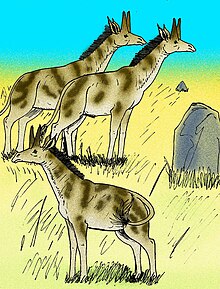| Honanotherium Temporal range: Late Miocene | |
|---|---|

| |
| Mounted skeleton in Henan Geological Museum | |
| Scientific classification | |
| Domain: | Eukaryota |
| Kingdom: | Animalia |
| Phylum: | Chordata |
| Class: | Mammalia |
| Order: | Artiodactyla |
| Family: | Giraffidae |
| Genus: | †Honanotherium Bohlin, 1927 |
| Species | |
| |
Honanotherium is a genus of extinct giraffid from the late Miocene of Henan Province, China, and East Azerbaijan Province, northwestern Iran. It was closely related to Bohlinia and was once thought to be ancestral to the modern giraffe (genus Giraffa). The living animal would have resembled a modern giraffe, but was somewhat shorter, with more massive ossicones.
The first part of the generic name, honano refers to the Henan (Chinese: 河南; pinyin: Hénán) province of China, where the first specimens were recovered. The second part, therium, comes from the Greek, θηρίον which means "beast."
Paleobiology

Like the modern-day giraffe, Honanotherium may have grazed on low-lying trees in the savannah environment, although its shorter neck shows that it probably fed on different plants than the extant giraffe.
References
- ^ Nikos Solounias and Melinda Danowitz (2016). "The Giraffidae of Maragheh and the identification of a new species of Honanotherium". Palaeobiodiversity and Palaeoenvironments. in press. doi:10.1007/s12549-016-0230-7.
- Bohlin, B. 1927. Die Familie Giraffidae. Pal. Sinica, Ser. C, IV, Fasc. 1, various pages.
 | This prehistoric even-toed ungulate-related article is a stub. You can help Misplaced Pages by expanding it. |